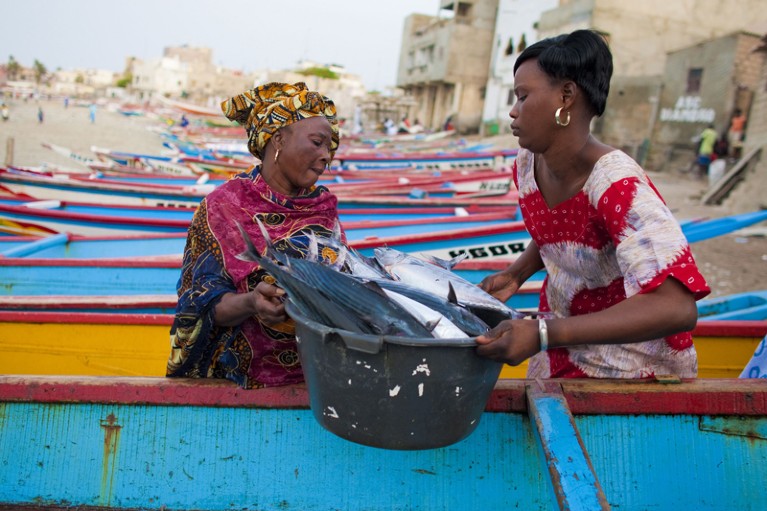
If coastal communities were able to keep back a fraction more of their catches, that would mean more micronutrients for children.Credit: Nic Bothma/EPA/Shutterstock
Economic stability was the great promise of industrial farming in replacing subsistence agriculture. Farming on a larger scale meant that families could produce enough both to feed their families and to sell on to local and international markets.
But as Christina Hicks at the University of Lancaster, UK, and her colleagues show in a paper in this week’s Nature, families — especially children — of artisanal fishers across Africa and Asia are suffering because of the demands of the aquaculture industry (C. C. Hicks et al. Nature 574, 95–98; 2019).
The problem, which is widely recognized, is that coastal communities are selling increasing amounts of their catch to aquaculture corporations. These fish are ground down to produce fishmeal, which is fed to farmed fish that are bought by wealthier consumers. But owing to expanding demand for farmed fish, more catches of fresh fish are being diverted away from local markets — and from the diets of children in coastal communities.
Globally, two billion people are deficient in essential micronutrients, such as iron, zinc, selenium, vitamin A and omega-3 fatty acids. There are one million premature deaths every year because people are not getting the right micronutrients. A lack of calcium, iron and zinc, for example, can cause stunted growth and anaemia. And yet just 100 grams of fish a day could provide half the recommended dietary allowance of iron and zinc for a child under five years of age.
Hicks and her team worked out the quantity of micronutrients obtained from catches of 367 species of fish in 43 countries, and then compared this with the prevalence of nutrition-linked diseases in communities within 100 kilometres of a coastline. They found that, in some countries, if fishers could hold back just a fraction of what they catch, that would be enough to provide families with healthier diets.
In Namibia, for example, 9% of fish caught in the country’s Exclusive Economic Zone would be sufficient to provide the iron needs of the entire coastal population. In Kiribati, 1% of catches would cover the necessary calcium for all of the country’s under-fives. In another 22 countries in Asia and West Africa, one-fifth or less of catches would fulfil the dietary needs of all under-fives.
These are troubling data, but producers and consumers can make a difference. Consumers of farmed fish especially can demand that producers find ways to improve the health and nutrition of coastal communities — for example by ensuring that fishers get to keep more of their catches. This isn’t a difficult request, and it could make the difference between a child’s life and her untimely death.

 Read the paper: Harnessing global fisheries to tackle micronutrient deficiencies
Read the paper: Harnessing global fisheries to tackle micronutrient deficiencies
 How the global fish market contributes to human micronutrient deficiencies
How the global fish market contributes to human micronutrient deficiencies






